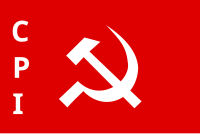Tebhaga movement
| Tebhaga movement | |||
|---|---|---|---|
| Part of Cold War and Peasant Revolution | |||
 | |||
| |||
| Belligerents | |||
|
|
| ||
| Commanders and leaders | |||
|
|
| ||
| Units involved | |||
| Indian Police Service | West Bengal group | ||
Tebhaga movement (1946–1947) was significant peasant agitation, initiated in Bengal by the All India Kisan Sabha of peasant front of the Communist Party of India.
History[]
Overview[]
At that time sharecroppers had contracted to give half of their harvest to the landlords. The demand of the Tebhaga (sharing by thirds) movement was to reduce the landlord share to one third.[1]
| Part of a series on |
| Communism in India |
|---|
 |
|
|
In many areas the agitations turned violent, and landlords fled, leaving parts of the countryside in the hands of Kisan Sabha. In 1946, sharecroppers began to assert that they would pay only one-third and that before division the crop would stay in their godowns and not that of the Jotedars. The sharecroppers were encouraged by the fact that the had already made this recommendation in its report to the government. The movement resulted in clashes between Jotedars and Bargadars (sharecroppers).
As a response to the agitation, the Muslim League ministry in the province launched the , which provided that the share of the harvest given to the landlords would be limited to one third of the total. However, the law was not fully implemented. The Bengal Land Revenue Commission popularly known as Floud Commission had made recommendation in favour of the share-croppers.
The movement in 24 Parganas[]
During the Bengal Famine of 1943 the Communist Party of India provided relief to the peasantry of the Sundarbans area. In September 1946 Bangiya Pradeshik Kisan Sabha decided to launch the Tebhaga movement. The peasant movement broke out in Kakdwip, Sonarpur, Bhangar and Canning. Kakdwip and Namkhana were the storm centres of the movement. The movement aimed at improving the share of the peasant engaged as sharecroppers. The prominent leaders of the movement were: Kansari Halder, Ganesh Das, Ashoke Bose and Rash Behari Ghosh. Peasant leaders like Gajen Malik, Manik Hazra, Jatin Maity, Bijoy Mondal and others rose to prominence. The movement continued till 1950, when the Bargadari Act was enacted. The Act recognised the right of the sharecropper to two-thirds of the produce when he provided the inputs.[2]
During 1946-1950 the Tebhaga movement in several parts of the 24 Parganas district led to the enactment of the Bargadari Act. Although the Bargadari Act of 1950 recognised the rights of bargadars to a higher share of crops from the land that they tilled, it was not implemented. Large tracts, beyond the prescribed limit of land ceiling, remained with the rich landlords. In 1967, West Bengal witnessed peasant uprising, against non-implementation of land reforms legislation, starting from Kheadaha gram panchayat in Sonarpur CD block. From 1977 onwards major land reforms took place in West Bengal under the Left Front government. Land in excess of land ceiling was acquired and distributed amongst the peasants. Subsequently, “Operation Barga” was aimed at securing tenancy rights for the peasants.[3]
Impact[]
Hare Krishna Konar played a leading role in getting surplus land held by big land owners in excess of land ceiling laws and kept ‘benami’ (or false names) vested with the state. The quantum of land thus vested was around one million acres (4,000 km²) of good agricultural land. Subsequently, under the leadership of Benoy Choudhury, this land was distributed amongst 2.4 million landless and poor farmers.[4]
Leaders[]
- Ila Mitra
- Kansari Halder
- Moni Singh
- Bishnu Chattopadhyay
- M.A. Rasul
- Moni Guha
- Charu Majumdar
- Haji Mohammad Danesh
- Sushil Sen
- Subodh Roy
- Ganesh Das
- Abani Lahiri
- Gurudas Talukdar
- Samar Ganguly
- Bimola Mandal
- Sudher Mukherjee
- Sudipa Sen
- Moni Krishna Sen
- Budi ma (বুড়ি মা)
- Niyamat Ali
See also[]
References[]
- ^ Asok Majumdar (2011). The Tebhaga Movement : Politics of Peasant Protest in Bengal 1946-1950. Aakar Books. p. 13. ISBN 978-9350021590.
- ^ "District Human Development Report: South 24 Parganas". Chapter 1.2, South 24 Parganas in Historical Perspective, pages 7-9. Development & Planning Department, Government of West Bengal, 2009. Archived from the original on 5 October 2016. Retrieved 3 November 2019.
- ^ "District Human Development Report: South 24 Parganas". (1) Chapter 1.2, South 24 Parganas in Historical Perspective, pages 7-9 (2) Chapter 3.4, Land reforms, pages 32-33. Development & Planning Department, Government of West Bengal, 2009. Archived from the original on 5 October 2016. Retrieved 3 November 2019.
- ^ "The story of a pretender". The Statesman, 9 February 2010. Archived from the original on 7 August 2011. Retrieved 12 November 2010.
- Kunal Chattopadhyay, Tebhaga Andolaner itihas, Progressive Publishers, Kolkata, 1986
- Susnata Das, "Abibhakta Banglar Krishak Sangram :Tebhaga Andolan(1946–47),Kolkata,2002(in Bengali)
- Adrienne Cooper, Sharecropping
- Tebhaga Sketches and Wood Engravings by Somnath Hore
- Chapter on Tebhaga movement in Jyoti Basu's memoirs
- 1946 establishments in India
- 1946 in British India
- Rebellions in India
- Indian independence movement
- Peasant revolts
- Debt bondage in South Asia
- Political uprisings in India
- Debt bondage in India
- Conflicts in 1946
- Basirhat
- Communist Party of India